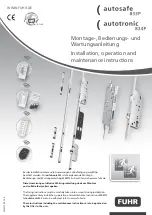
Mit dem Drücker/Stangengriff alle
Verriegelungselemente einziehen.
Bei dieser Beschlagstellung den
Zylinderschlüssel in Verschluss-
richtung bis zum Anschlag drehen.
2
1
Alle Verriegelungselemente bleiben
nun eingezogen.
Zur Lösung der Fallenfeststellung
den Zylinderschlüssel in Öffnungs-
richtung bis zum Anschlag drehen.
4
3
1
3
2
4
6
WWW.FUHR.DE
Locking function
autosafe
833P – single-leafed:
Panic function E:
Upon closing the door all latches and the
main deadbolt extend automatically. It is opened from the
inside by operating either the lever-handle or the push bar,
and from the outside via the profile cylinder key.
Panic function B:
As above, but the exterior lever-handle
can also be activated or deactivated via the profile cylinder
key. The original position and/or operating position (exterior
lever-handle activated or deactivated) remain in force regard-
less of the panic opening operation.
autosafe
833P – double-leafed:
Panic function E:
Upon closing both doors all latches and
the main deadbolt (active leaf) and all connecting-rods
(passive leaf) extend automatically. Unhindered escape from
inside by operating the lever-handle or push bar; on both
the active leaf as well as on the passive leaf. When opening
the passive leaf in an emergency, the panic lock keeper’s
connecting-rods are retracted and all of the active leaf’s
locking points are retracted simultaneously. The connecting-
rods automatically latch in this position. As a result, hinde-
ring closing the passive leaf is prevented and also the floor
coverings cannot be damaged. Only when the passive leaf
is closed, does a switching lock automatically trigger locking
the rods at the top and bottom.
Panic function B:
As above, but the active leaf’s exte-
rior lever-handle can also be activated or deactivated
via the profile cylinder key. The original position and/or
operating position (exterior lever-handle activated or deac-
tivated) remain in force regardless of the panic opening
operation.
Operation instructions
autotronic
834P – single-leafed:
Panic function E:
Upon closing the door all latches and the
main deadbolt extend automatically. It is opened from the
inside by operating either the lever-handle or the push bar,
and from the outside via the profile cylinder key. In addition
it is possible to open by means of the FUHR radio controlled
access control modules or any other access control system.
Panic function B:
As above, but the exterior lever-handle
can also be activated or deactivated via the profile cylinder
key. The original position and/or operating position (exterior
lever-handle activated or deactivated) remain in force regard-
less of the panic opening operation.
autotronic
834P – double-leafed:
Panic function E:
Upon closing both doors all latches and
the main deadbolt (active leaf) and all connecting-rods
(passive leaf) extend automatically. Unhindered escape from
inside by operating the lever-handle or push bar; on both
the active leaf as well as on the passive leaf. When opening
the passive leaf in an emergency, the panic lock keeper’s
connecting-rods are retracted and all of the active leaf’s
locking points are retracted simultaneously. The connecting-
rods automatically latch in this position. As a result, hinde-
ring closing the passive leaf is prevented and also the floor
coverings cannot be damaged. Only when the passive leaf
is closed, does a switching lock automatically trigger locking
the rods at the top and bottom.
Panic function B:
As above, but the exterior lever-handle
can also be activated or deactivated via the profile cylinder
key. The original position and/or operating position (exterior
lever-handle activated or deactivated) remain in force regard-
less of the panic opening operation.
autosafe
833P/
autotronic
834P –
controlled latch locking device:
This optional feature is available on the panic function E.
Please note that this function is not permissible for fire and
smoke protection doors.
Activating the controlled latch locking device
Retract all locking components by operating the lever-handle
or push-bar (1) and turn the profile cylinder key as far as it
will go in the locking direction (2). Release the lever-handle
or push bar again, turn back and remove the profile cylinder
key (3). All locking components now remain retracted.
Disengaging the controlled latch locking device
Turn the profile cylinder key as far as it will go in the opening
direction, turn back and remove the profile cylinder key (4).
All locking components are now released again.


































